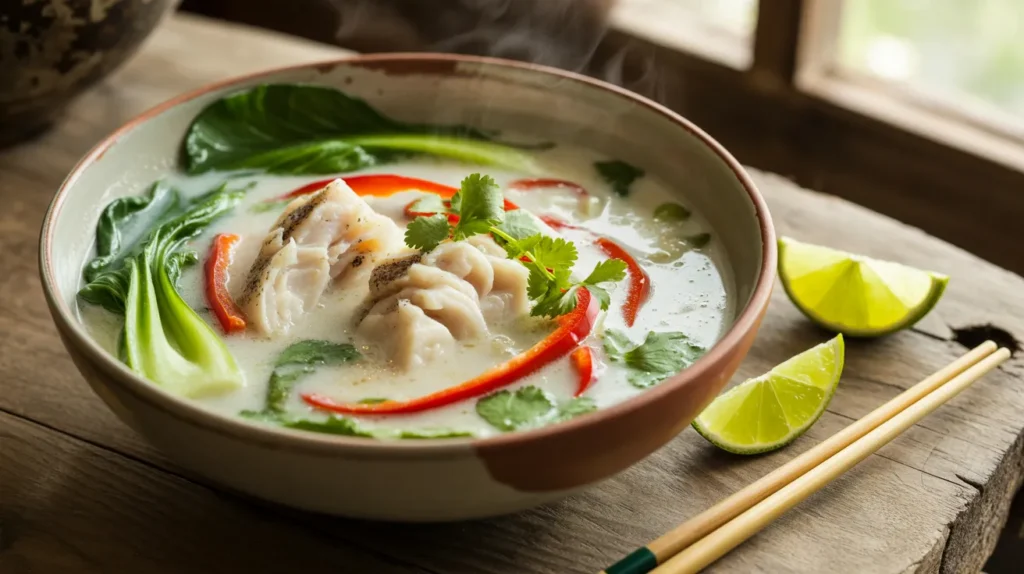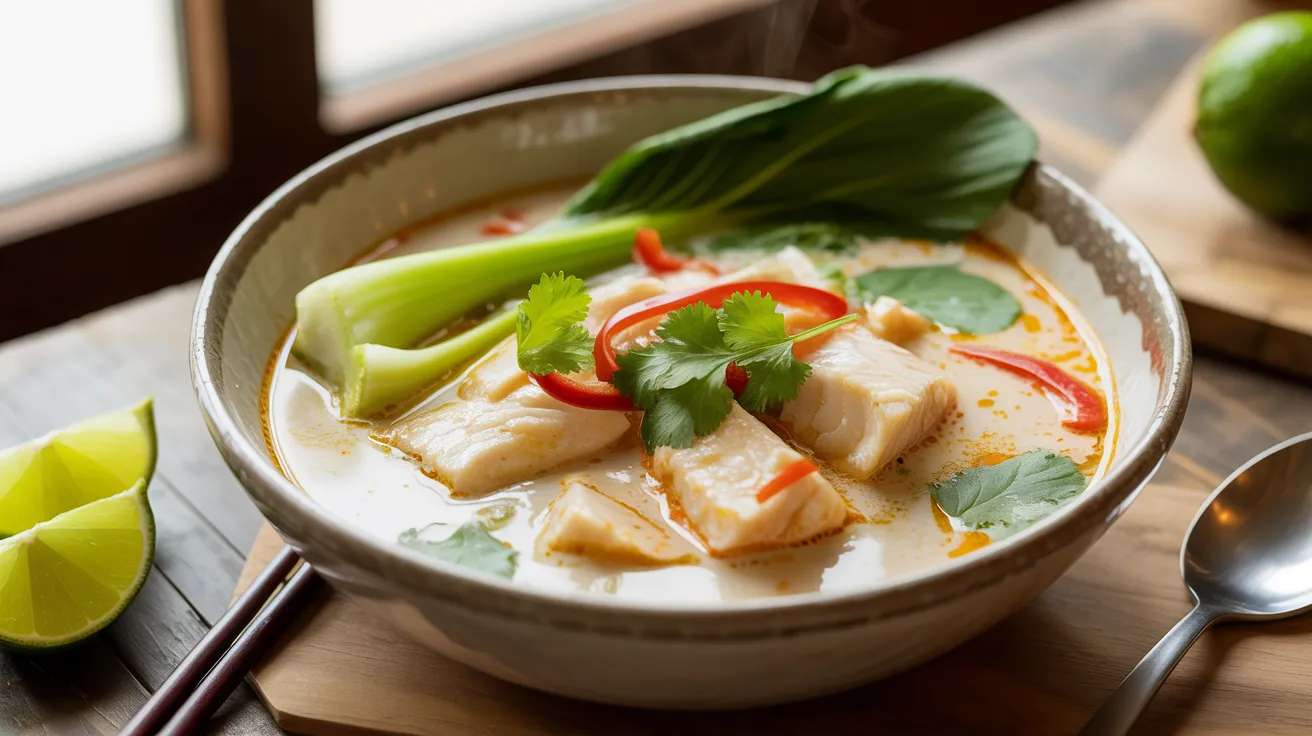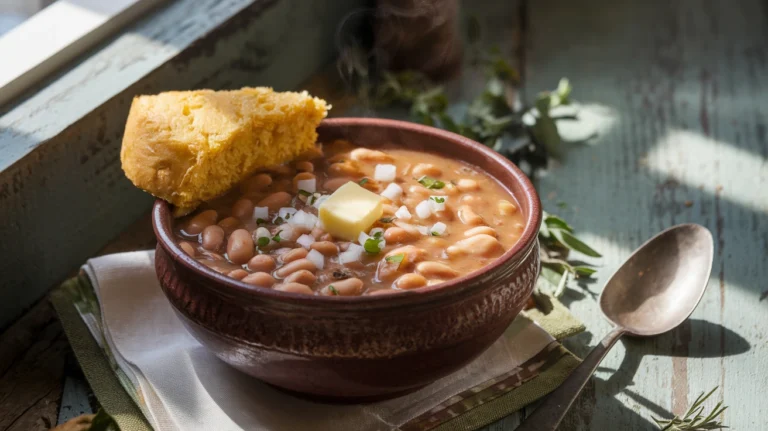This aromatic coconut lime fish soup combines tender white fish with creamy coconut milk and zesty lime in a restaurant-quality dish you can make at home. Our step-by-step coconut lime fish soup recipe is perfect for beginners, with detailed instructions that guarantee delicious results every time.
SERVES: 4 | PREP: 20 MIN | COOK: 25 MIN | TOTAL: 45 MIN
Ingredients for Perfect Coconut Lime Fish Soup
Proteins & Aromatics
| Ingredient | Amount |
|---|---|
| White fish fillets (cod, halibut, or mahi-mahi) | 1½ lbs, cut into 2-inch pieces |
| Fresh ginger | 2 tablespoons, minced |
| Garlic cloves | 4 large, minced |
| Lemongrass stalks | 2, bruised and cut into 3-inch pieces |
| Thai red curry paste | 2 tablespoons |
Liquids & Seasonings
| Ingredient | Amount |
|---|---|
| Full-fat coconut milk | 2 cans (14 oz each) |
| Fish stock or chicken broth | 2 cups |
| Fresh lime juice | ¼ cup (about 2 large limes) |
| Fish sauce | 2 tablespoons |
| Brown sugar | 1 tablespoon |
Vegetables & Garnishes
| Ingredient | Amount |
|---|---|
| Red bell pepper | 1 large, sliced thin |
| Baby bok choy | 4 heads, halved lengthwise |
| Fresh cilantro | ½ cup, chopped |
| Green onions | 3, sliced thin |
| Lime wedges | For serving |
| Thai basil leaves | ¼ cup (optional) |
Detailed Step-by-Step Instructions for Coconut Lime Fish Soup
Phase 1: Essential Prep Work (10 minutes)
Step 1: Prepare Your Fish Properly Remove your fish from the refrigerator 10 minutes before cooking to bring it closer to room temperature. Pat each fillet completely dry using paper towels – this is crucial because wet fish will cause oil to splatter and won’t cook evenly. Using a sharp knife, cut the fish into uniform 2-inch pieces. Uniform pieces ensure even cooking. Season lightly with ½ teaspoon of salt and set aside on a clean plate. Don’t season too early as salt will draw out moisture.
Step 2: Create Your Aromatics Base Peel a 2-inch piece of fresh ginger using the edge of a spoon (this removes just the skin without wasting ginger). Mince the ginger finely – you want pieces no larger than rice grains. Peel 4 large garlic cloves and mince them equally fine. Combine the minced ginger and garlic in a small bowl. For lemongrass, remove the tough outer layers until you reach the tender white-green core. Cut into 3-inch pieces, then lay your knife flat and press firmly to bruise the stalks – you should hear them crack. This releases the aromatic oils essential for authentic coconut lime fish soup flavor.
Step 3: Prep All Vegetables Wash and dry your red bell pepper thoroughly. Cut it in half, remove seeds and white pith, then slice into thin strips about ¼-inch wide. For bok choy, trim the bottom ½ inch off each head, then cut in half lengthwise. Rinse under cold water and shake dry. Roughly chop cilantro leaves (save stems for another use), and slice green onions on the diagonal into thin pieces. Having everything prepped beforehand is crucial because this coconut lime fish soup cooks quickly once you start.
Phase 2: Building the Flavor Base (8 minutes)
Step 4: Heat Your Pot Correctly Use a heavy-bottomed pot or Dutch oven – thin pots can cause hot spots that burn your curry paste. Heat over medium heat for 2 minutes until you can feel warmth when you hold your hand 4 inches above the surface. Open one can of coconut milk and carefully scoop out 1 tablespoon of the thick cream that’s separated on top – this is your cooking fat. Add it to the warm pot and swirl to coat the bottom.
Step 5: Bloom Your Curry Paste Add 2 tablespoons of Thai red curry paste to the warm oil. Using a wooden spoon, stir constantly for 30-45 seconds. You’ll know it’s ready when you smell the spices becoming fragrant and the paste darkens slightly. Don’t let it burn – if it starts sticking or smoking, lower the heat immediately. This step is crucial for developing deep flavor in your coconut lime fish soup.
Step 6: Add Aromatics Carefully Add your prepared ginger-garlic mixture and bruised lemongrass pieces to the fragrant curry paste. Stir constantly for 1-2 minutes. The mixture should sizzle gently – if it’s too quiet, raise the heat slightly; if it’s spattering aggressively, lower the heat. You’ll smell an amazing aroma when the garlic becomes fragrant but hasn’t turned brown. Brown garlic tastes bitter, so watch carefully.
Step 7: Incorporate Coconut Milk Smoothly This step prevents curdling, which can ruin your coconut lime fish soup. Start by adding just ½ cup of coconut milk to the aromatic paste. Whisk vigorously to create a smooth, thick paste with no lumps. Once smooth, gradually add the remaining coconut milk from both cans while whisking constantly. The mixture should be creamy and uniform in color. If you see any curdling (lumpy texture), whisk more vigorously and lower the heat.
Phase 3: Creating the Perfect Broth (10 minutes)
Step 8: Add Stock Gradually Pour in your fish stock or chicken broth slowly while stirring. Start with 1 cup, stir well, then add the remaining cup. This gradual addition helps maintain the smooth texture. Bring the mixture to a gentle simmer over medium-low heat – you should see small bubbles around the edges, not a rolling boil. A rolling boil can cause the coconut milk to separate and look grainy.
Step 9: Season Your Broth Base Add 2 tablespoons of fish sauce and 1 tablespoon of brown sugar. Stir well and let simmer for 2 minutes. Taste the broth carefully (it will be hot!) – you should taste salt from the fish sauce, slight sweetness from the sugar, and creamy richness from the coconut milk. The flavor should be well-balanced but not yet complete – the lime juice comes later.
Step 10: Let Flavors Develop Allow the broth to simmer gently for 5 more minutes, stirring occasionally. This simmering time allows all the flavors to meld together. The broth should coat the back of a spoon lightly – if it’s too thin, simmer uncovered for a few more minutes. If it’s too thick, add ¼ cup more stock. Your kitchen should smell incredible at this point, with coconut and spice aromas filling the air.
Phase 4: Adding Vegetables Strategically (6 minutes)
Step 11: Add Bell Peppers First Bell peppers need more cooking time than bok choy, so they go in first. Add your sliced red bell pepper strips to the simmering broth. Stir gently to submerge them. Let them cook for 3-4 minutes until they’re slightly softened but still have a bit of crunch. They should be bright red and tender-crisp when done.
Step 12: Add Bok Choy Carefully Nestle the bok choy halves into the simmering coconut lime fish soup with the cut side facing down. Don’t stir aggressively – just gently push them down into the liquid. The green leaves will wilt quickly (about 2 minutes) while the white stems stay slightly crisp. This textural contrast is what makes the soup interesting.
Phase 5: Cooking Fish to Perfection (5 minutes)
Step 13: Add Fish Gently This is the most critical step for perfect coconut lime fish soup. Reduce heat to low-medium. Using a large spoon, gently lower each piece of fish into the simmering broth. Don’t drop them in or stir immediately – let them settle first. The fish should be mostly submerged in the liquid. If some pieces stick out, gently spoon some broth over them.
Step 14: Cook Fish Without Stirring Here’s where patience pays off. Let the fish cook undisturbed for 3-4 minutes. You’ll see the edges start to turn opaque white, then this color will gradually work its way toward the center. The fish is done when it flakes easily with a fork and has reached an internal temperature of 145°F. If you must move pieces, use a spoon rather than stirring, which can break apart the delicate fish.
Step 15: Remove Aromatics Using tongs, carefully remove the lemongrass pieces. They’ve done their job of flavoring the broth and would be unpleasant to bite into. If you can’t find all pieces, don’t worry – just warn your diners to watch for them.
Phase 6: Final Touches and Serving (3 minutes)
Step 16: Add Lime Juice Off Heat Remove your pot from the heat completely before adding lime juice. Heat destroys the bright, fresh flavor of citrus. Start with 3 tablespoons of fresh lime juice, stir gently, then taste. Add more lime juice 1 tablespoon at a time until you achieve the perfect balance. The lime should brighten all the other flavors without being overpowering.
Step 17: Final Seasoning Adjustments Taste your coconut lime fish soup carefully and adjust seasonings. Need more saltiness? Add fish sauce ½ teaspoon at a time. Want more brightness? Add more lime juice. Need more heat? Stir in ½ teaspoon more curry paste (mixed with a little hot broth first). The final soup should be creamy, aromatic, with a perfect balance of salty, sweet, and tangy flavors.
Step 18: Garnish and Serve Immediately Ladle the coconut lime fish soup into warm bowls, making sure each serving gets fish, vegetables, and plenty of broth. Garnish generously with chopped fresh cilantro, sliced green onions, and Thai basil if using. Serve with lime wedges on the side so each person can add more brightness to taste. Provide spoons and chopsticks or forks for the best eating experience.
Chef’s Professional Tips for Perfect Coconut Lime Fish Soup
Coconut Milk Quality Matters: Always use full-fat coconut milk for the richest, creamiest coconut lime fish soup. Light versions lack the fat content needed for proper texture and mouthfeel.
Fish Selection Strategy: Choose firm white fish that won’t disintegrate during cooking. Cod, halibut, and mahi-mahi are excellent choices, while delicate fish like sole or flounder may fall apart.
Heat Control is Critical: Keep temperatures moderate throughout cooking. High heat can cause coconut milk to curdle and fish to become tough and rubbery.
Fresh Herb Timing: Add cilantro, basil, and lime juice only at the very end to preserve their bright flavors and vibrant colors in your finished coconut lime fish soup.
Complete Nutrition Information (Per Serving)
- Calories: 385
- Protein: 28g
- Carbohydrates: 12g
- Fat: 27g
- Fiber: 3g
- Sodium: 890mg
- Vitamin C: 45mg (from lime and vegetables)
Creative Coconut Lime Fish Soup Variations
Spicy Seafood Coconut Lime Fish Soup
Transform your basic recipe by adding ½ pound of medium shrimp (peeled and deveined) and 8 oz of cleaned mussels during the last 3 minutes of cooking. The shellfish adds natural sweetness that beautifully complements the coconut base.
Vegetarian Thai Coconut Soup
Replace fish with 1 lb of extra-firm tofu (cubed and lightly pan-fried first) and use vegetable broth instead of fish stock. This plant-based version pairs wonderfully with our sausage white bean soup for a complete meal spread.
Noodle Bowl Style Coconut Lime Fish Soup
Serve over cooked rice noodles, ramen noodles, or jasmine rice to create a more substantial meal. The starches absorb the flavorful coconut broth beautifully, making each bite more satisfying.
Mediterranean Fusion Version
Create an interesting fusion by swapping Thai curry paste for harissa and adding diced tomatoes. This creates a unique flavor profile reminiscent of our bouillabaisse seafood stew but with tropical coconut richness.
Storage and Reheating Your Coconut Lime Fish Soup
Proper Refrigerator Storage: Store leftover coconut lime fish soup in airtight containers for up to 3 days. The flavors actually improve overnight as they continue to meld together.
Gentle Reheating Method: Warm over low heat, stirring occasionally with a wooden spoon. Never bring to a rolling boil as this can cause the coconut milk to separate and the fish to become tough.
Freezing Considerations: This coconut lime fish soup doesn’t freeze well due to the coconut milk base, which tends to separate and become grainy when thawed.
Smart Make-Ahead Strategy: Prepare the complete broth base through step 10, then refrigerate. When ready to serve, reheat the broth and add fresh vegetables and fish for optimal texture and flavor.

Comprehensive Troubleshooting Guide
Problem: My coconut milk is curdling and looks lumpy
Solution: Immediately lower the heat and whisk vigorously. If severely curdled, strain the soup and start over with fresh coconut milk. Prevention: Never let coconut milk boil rapidly, and always temper it by adding gradually to warm ingredients.
Problem: The fish is falling apart and looks mushy
Solution: Next time use firmer fish varieties and handle more gently. For this batch, serve immediately without additional stirring. Prevention: Choose firm fish, don’t overcook, and avoid aggressive stirring once fish is added.
Problem: My coconut lime fish soup is too spicy to eat
Solution: Add an additional can of coconut milk or 2 tablespoons of brown sugar to balance the heat. A squeeze of lime juice can also help. Prevention: Start with less curry paste and build up to your desired heat level.
Problem: The flavors taste flat and one-dimensional
Solution: Add more fish sauce for umami depth, fresh lime juice for brightness, and a pinch of brown sugar for balance. Prevention: Taste and adjust seasonings throughout the cooking process.
Problem: The broth is too thin and watery
Solution: Simmer uncovered for 10 more minutes to concentrate flavors, or whisk in 1 tablespoon of cornstarch mixed with 2 tablespoons of cold water. Prevention: Use full-fat coconut milk and don’t add too much stock initially.
Essential Equipment for Making Coconut Lime Fish Soup
- Heavy-bottomed pot or Dutch oven (minimum 4-quart capacity for even heat distribution)
- Sharp chef’s knife for efficient prep work
- Large cutting board (preferably separate for fish to prevent cross-contamination)
- Wire whisk for smooth coconut milk incorporation
- Wooden spoon for gentle stirring without scratching your pot
- Ladle for elegant serving
- Tongs for removing lemongrass and handling delicate ingredients
- Small prep bowls for organized mise en place
Organized Shopping List for Coconut Lime Fish Soup
Fresh Seafood Counter
- 1½ lbs white fish fillets (cod, halibut, or mahi-mahi)
Fresh Produce Section
- Fresh ginger (2-inch piece needed)
- 1 large head of garlic
- 2 fresh lemongrass stalks
- 1 large red bell pepper
- 4 baby bok choy heads
- 1 bunch fresh cilantro
- 3 green onions
- 2-3 fresh limes (for ¼ cup juice plus wedges)
- Thai basil (optional, if available)
International/Asian Aisle
- 2 cans full-fat coconut milk (14 oz each)
- Thai red curry paste
- Fish sauce
- Brown sugar
Pantry/Soup Aisle
- Fish stock or chicken broth (32 oz container)
Five Essential Success Secrets
- Master temperature control – Keep heat at medium-low once coconut milk is added to prevent curdling and ensure silky smooth texture in your coconut lime fish soup.
- Complete all prep work first – This soup moves quickly once you start cooking, so having everything chopped, measured, and ready prevents overcooking and ensures perfect timing.
- Never skip the curry paste blooming step – Sautéing the paste releases essential oils and deepens flavors that make the difference between good and exceptional coconut lime fish soup.
- Add lime juice off the heat only – Heat destroys the bright, fresh citrus flavor that gives this soup its characteristic zing and balances the rich coconut base.
- Serve immediately for best results – This coconut lime fish soup is at its absolute peak when freshly made, with optimal texture and vibrant flavors that can diminish over time.
This comprehensive coconut lime fish soup recipe delivers authentic Thai flavors with foolproof techniques that guarantee success every time. The combination of creamy coconut milk, zesty lime, tender fish, and aromatic spices creates a bowl of comfort that’s both exotic and accessible to home cooks of all skill levels.




